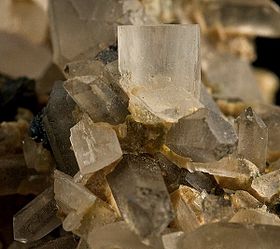- Bertrandite
-
Bertrandite[1]
Catégorie IX : silicates[2]
Bertrandite du Kazakhstan Général Classe de Strunz 9.BD.05 Formule brute Be4Si2O7(OH)2 Identification Masse formulaire[3] 238,2302 ± 0,0035 uma
H 0,85 %, Be 15,13 %, O 60,44 %, Si 23,58 %,
238,23 umaCouleur incolore à jaune pâle Classe cristalline et groupe d'espace Orthorhombique - Pyramidale ; Ccm21 Système cristallin orthorhombique Réseau de Bravais Centré C Macle Commun sur {011} ou {021} avec des axes de 60 ou 120 ° Clivage Parfait à {001} ; Distinct à {110} et {101} Cassure conchoïdale Habitus Tabulaire; prismatique; aciculaire; agrégat; radié; grenu; lamellaire Échelle de Mohs 6 - 7 Trait blanc Éclat vitreux à nacré Propriétés optiques Indice de réfraction nα=1,591 nβ=1,605 nγ=1,614 Biréfringence Δ=0,023 ; biaxe négatif Dispersion 2vz ~ 76 Fluorescence ultraviolet aucune Transparence translucide à transparent Propriétés chimiques Densité 2,59 Propriétés physiques Magnétisme aucun Radioactivité aucune Unités du SI & CNTP, sauf indication contraire. La bertrandite est une espèce minérale du groupe des silicates sous groupe des sorosilicates, formée d'hydroxyde sorosilicate de béryllium de composition chimique : Be4Si2O7(OH)2 avec des traces : Al;Fe;Ca. Elle est pyroélectrique. Les cristaux, de faciès proche des tourmalines peuvent atteindre 5 cm [4].
Sommaire
Inventeur et étymologie
Le découvreur est Baret qui le premier a trouvé ce minéral dans les granulites de Petit-Port près de Nantes. Les échantillons ont été confié à Emile Bertrand pour une première analyse en 1880[5] C'est Alexis Damour en 1883 qui en fait une description complète ; il en est l'inventeur et a dédié l'espèce à Emile Bertand minéralogiste et ingénieur des mines français.
Topotype
- Carrière Barbin et Petit-port, Nantes, Loire-Atlantique, France
- Les échantillons types sont déposés à l'école nationale supérieure des mines de Paris.
Cristallographie
- Paramètres de la maille conventionnelle : a = 15,22 Å, b = 8,69 Å, c = 4,54 Å ; Z = 4 ; V = 600,47 Å3
- Densité calculée = 2,64 g⋅cm-3
Gîtologie
Elle est communément trouvée dans les pegmatites riches en béryllium et est en partie une modification du béryl. La bertrandite se produit souvent comme un remplacement pseudomorphique du béryl. Avec le béryl, elle forme le minerai du béryllium.
Minéraux associés
Béryl, phénakite, herdérite, tourmaline, muscovite, fluorine, quartz.
Gisements remarquables
- Brésil
- Golconda mine, près Governador Valadares, Minas Gerais
- Etat-unis
- Strickland quarry, Portland, Comté de Middlesex, Connecticut
- Amelia, Comté d'Amelia, Virginie
- Pala district, Comté de San Diego, Californie
- Italie
- Val Vigezzo, Piémont
- Kazakhstan
- Akchatau, Kara-Oba, et Kounrad
- Mexique
- Sierra de Aguachile,Acuna, Coahuila,
- Namibie
- Klein Spitzkopje
Notes et références
- American Mineralogist, volume 072, pp. 979(1987)
- La classification des minéraux choisie est celle de Strunz.
- Masse molaire calculée d’après Atomic weights of the elements 2007 sur www.chem.qmul.ac.uk
- The Handbook of Mineralogy Volume II, 1995 Mineralogical Society of America by Kenneth W. Bladh, Richard A. Bideaux, Elizabeth Anthony-Morton and Barbara G. Nichols
- Minéralogie de la France, Volume 1, Partie 1 par Alfred Lacroix Paris 1895. p.115
- Portail des minéraux et roches
- Portail de la chimie
Catégories :- Béryllium (minéral)
- Composé du silicium
- Hydroxyde (minéral)
- Sorosilicate
Wikimedia Foundation. 2010.

